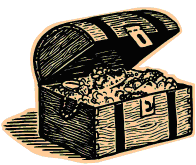Ask Professor Puzzler
Do you have a question you would like to ask Professor Puzzler? Click here to ask your question!
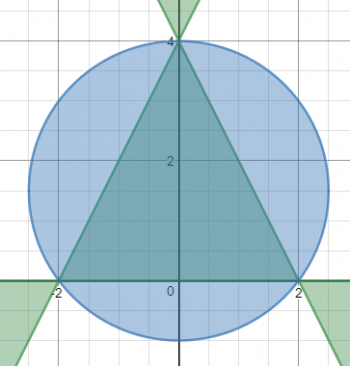
I was up at 3:30 AM today, so I decided to create a Christmas graph for all of my friends. This graph is made up of several inequalities combined with ∩ (intersection) and ∪ (union), and I hope you'll stick with me to the end to see what it looks like. Are you ready?
Let B be the equation: y2 + 0.5y ≤ 0; {-0.5 ≤ x ≤ 0.5}
Let S be the equation: 81x4 - 18x2y2 + 153x2y -326.25x2 + y4 - 17y3 + 108.25y2 - 306y + 324 ≥ 0 {-1/12 ≤ x ≤ 1/12}
Let C1 be the equation: (x - 0.3)2 + (y - 2.5)^2 - 0.0625 ≤ 0
Let T be the equation: 4x2y - y3 + 8y2 - 16y ≤ 0
Let C2 be the equation: x2 + y2 - 3y - 4 ≤ 0
Let O be the equation: [(x - .3)2 + (y - 2.5)2 - 0.02][(x - .3)2 + (y - 2.5)2 - 0.02][(x - .3)2 + (y - 2.5)2 - 0.02] ≥ 0
Let G be the equation: (y - .1 - .2(x - 1)2)(y - .2 - .2(x - 1)2)(y - 1.3 - .2(x - 1)2)(y - 1.4 - .2(x - 1)2)(y - 2.2 - .2(x - 1)2)(y - 2.3 - .2(x - 1)2)(y - 3.2 - .2(x - 1)2)(y - 3.3 - .2(x - 1)2) ≥ 0
Now graph the following:
B ∪ (S ∩ C1) ∪ (T ∩ C2 ∩ O ∩ G)
Okay, okay, this thing is ugly. I'm going to make it a little less ugly by factoring S, B, and T for you. You should be able to factor B and T on your own, but I'm certainly not going to ask anyone to factor S, so I'll just tell you how it factors. If you want to factor B and T on your own, take a moment to do so before reading further.
S factors into: (3x + y - 4.5)(3x - y + 4.5)(3x - y + 4)(3x + y -4) ≥ 0 {-1/12 ≤ x ≤ 1/12}
B factors into y(y + 0.5) ≤ 0; {-0.5 ≤ x ≤ 0.5}
T factors into: y(2x + y - 4)(2x - y + 4) ≤ 0 (see the factoring process)
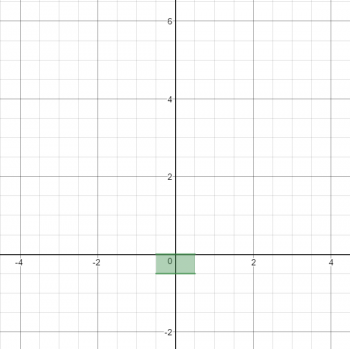
Let's begin by graphing the easiest part of this: B.
Since y(y + 0.5) ≤ 0, we can conclude that y must be between 0 and -0.5, so that the product of the two factors will be less than 0. However, we are also given the stipulation that x is between -0.5 and +0.5, which results in a simple box.
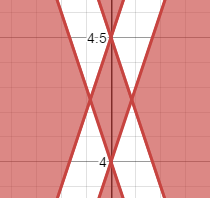
Now let's take a look at the intersection of S and C1. S is a multiplication of four factors which are all linear, and they are in parallel pairs, which means this is going to be a parallelogram. Inside the parallelogram, two of the factors are negative and two are positive, which makes the whole thing positive. The graph looks like the picture to the right.
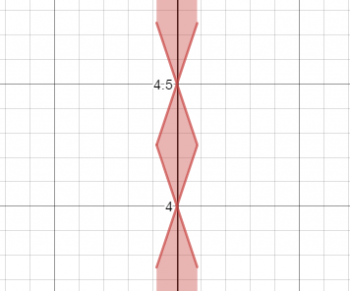
However, we have placed restrictions on the domain of this equation; x has to be between -0.5 and +05, which limits the graph as shown at the right.
We still are not finished with this section of the graph; we have to intersect this with the equation C1. This graph is a circle with center at (0, 4.25), and the interior of the circle is included. This further limits the graph to nothing but the rhombus.
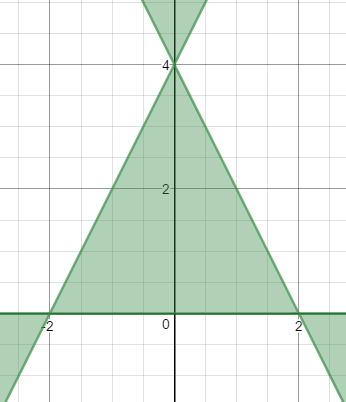
Okay, now the really challenging part. Equation T is very similar to equation S, except that instead of four factors, there are three. Thus, this contains a triangle, and since there are an odd number of factors, and they multiply to something less than or equal to zero, the interior of the triangle is included.

What's next? Well, in case you hadn't guessed C2 is also a circle, and we're intersecting the interior of the circle with the triangle graph, which gives us the next graph.
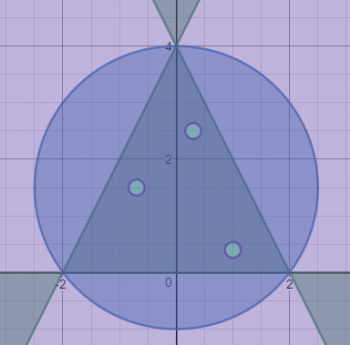
Then we have to deal with that hideous equation O, which appears to be...three circle factors multiplied together. If a point is on the interior of any of those three circles, that factor will be negative, and the other two will be positive, giving a negative result. However, equation O has the product greater than or equal to zero, which means that points satisfying O lie on or outside the three circles. The circles are all pretty small, and they're scattered around inside the triangle. Thus, we have the interior of a triangle, minus three circles, giving us the graph shown here.
What next? The even uglier equation G, which is a series of parabolas multiplied together as shown here.
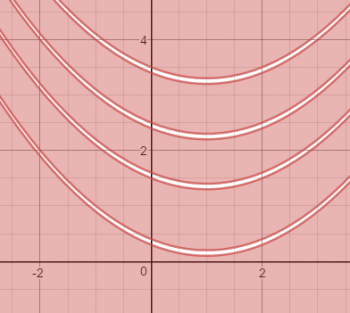
Now, if you were to take all of these and overlay them on top of one another, they would look something like this:
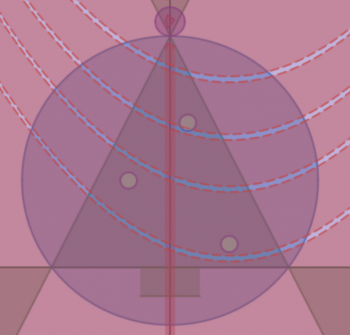
But...we're not overlaying them all; we have to take the intersection of T, C2, O and G, and we also have to take the intersection of S and C1. Then we overlay them (because it is a union of three separate graphs). I've shown them here with distinct colors for each of the three parts combined. Brown for the base (B), green for the tree (Tree ∩ Circle2 ∩ Ornaments ∩ Garland), and yellow for the star (Star ∩ Circle1).

Have a wonderful, Merry Christmas!
Professor Puzzler
P.S. Graph screen captures came from this graphing calculator.
Several months ago, Professor Puzzler wrote a blog post about the math problem "three over two x" (3/2x) and how it should be interpreted. The answer was: that's not a math problem; it's a typographical error, because fractions written with a diagonal bar, by typographical standards, should be written with the numerator a superscript, and the denominator a subscript, making it obvious whether the x is a part of the denominator, or separate from the fraction altogether.
A similar question has cropped up, and someone asked the Professor about how to interpret it: what is the answer when you perform the following operations:
6 ÷ 2(1 + 2)
This is another one of those facebook memes that people love to argue endlessly about. The primary arguments go as follows:
Argument #1
Do the parentheses first, giving you 6 ÷ 2 x 3. Now do the multiplication, giving: 6 ÷ 6. Now do the division and the answer is 1.
Argument #2
Do the parentheses first, giving you 6 ÷ 2 x 3. Now do the division, giving: 3 x 3. Now do the multiplication and the answer is 9.
Argument #3
Do the parentheses first, giving you 6 ÷ 2(3). Now do the parentheses (again), giving: 6 ÷ 6. Now do the division and the answer is 1.
Which of these arguments are valid?
Argument #1 is invalid, because once you're left with just division and multiplication, you do them from left to right. Multiplication does not take precedence over division! If you used argument #1, you should review BODMAS (PEMDAS).
Argument #2 is an acceptable argument. Here you're doing the multiplication and division from left to right, as required.
Argument #3 is also invalid, because "doing parentheses" means evaluating what's inside the parentheses, not combining them with things outside the parentheses.
Does that mean the answer is unequivocally 9? Or is there another argument to be made?
I'm going to stir the pot a little and suggest that there is another argument you could make.
Argument #4
BODMAS (PEMDAS) is a set of rules that is designed to tell us what to do with specific arithmetic operation graphemes*, and if we represent an arithmetic operation with a grapheme outside the set of graphemes, all bets are off.
* A grapheme is a visual, symbolic representation of something. For example, "A", "1", "÷" are all graphemes.
If you don't believe that using different graphemes can alter the order in which we do the problem, consider the following. Division can be represented by the symbol "÷" or by a vinculum (a horizontal fraction bar). With that in mind, are the following equivalent expressions?
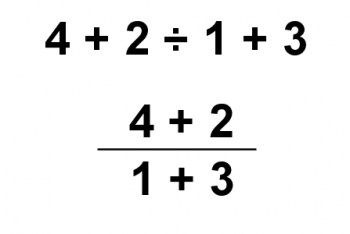
The answer is: of course they're not the same! The top expression is evaluated with 2 ÷ 1 calculated first, and then 4 + 2 + 3 = 9.
In the second expression, we evaluate the numerator and denominator first, giving 6 ÷ 4. Which gives 3/2 as the answer.
But they are both graphical representations of division! So why does the order of operations change? I tell my students that the vinculum is a "grouping symbol." In other words, it has implied parentheses. If you wanted to write it without the vinculum, you would have to add parentheses to the expression:
(4 + 2) ÷ (1 + 3)
Thus, even though the vinculum and "÷" are both division symbols, order of operations does not apply to them in exactly the same way.
In the same manner, one could argue that multiplication written with a different grapheme (in this case, the grapheme would be no grapheme at all) doesn't need to be interpreted in exactly the same way as multiplication written with the standard "x" grapheme. You could argue that in the same way that a vinculum as the division grapheme introduces implied parentheses into the problem, an empty grapheme for multiplication also introduces an implied grouping. In other words, 2(2 + 1) is actually an implied group: [2(2 + 1)]. This would change the answer to the original problem to 1 instead of 9.
And I would be hard pressed to provide a compelling argument against your interpretation, since I just got done telling you that a vinculum introduces an implied grouping!
Which leads us to the point I wanted to make from the beginning:
This is one of the reasons why, once we hit Algebra, we avoid using the ÷ grapheme for division. We almost entirely use a vinculum for division. Partly, that's because it allows us to be more compact in writing problems. But also because it becomes an implied grouping for division (allowing us to skip writing parentheses all over the place) AND it also avoids any chance of ambiguity that might arise from the question of how we write our multiplication. If a no-grapheme multiplication occurs under the vinculum, then it already has an implied grouping which it receives from the vinculum!
Veronica from Georgia asks, "A guy wants to buy a car and borrow $50,000. He gets $25,000 from his mom and $25,000 from his sister. He buys the car for $45,000. Driving home he runs into a friend that ask to borrow $3,000. You are now left with $2,000. You pay your mom and sister back $1,000 each and now you owe them only $24,000 each. After you pay them the $48,000 total to both, your friend pays you the $3000 he owes you. Do you know why the total comes out to $51,000 instead of $50,000 that you originally started out with?"
Hi Vernoica, This problem is very similar to the bellboy "missing dollar" problem, which you can read about by clicking the image below:
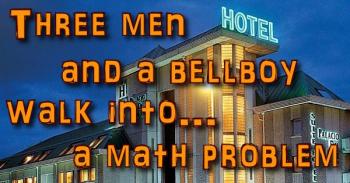
I'm going to use a slightly different approach in explaining this problem, by focusing on the meaning of positives and negatives in the context of transactions. Every financial transaction has a "direction." It is from one person (or organization/business, etc) and to another. We use positives and negatives to indicate the direction of a transaction. We should choose a single individual as the focus for our problem, and once we've done that, every transaction will be signed based on whether the transaction is TO or FROM that person. In this case, the choice is obvious: the guy buying the car is the focus.
So let's agree that if a monetary transaction has "the guy" as the recipient, we'll call that transaction positive. If "the guy" is the giver, we'll call it a negative transaction. So we can list every transaction as a signed number:
Recieves $25,000 from his mother: +$25,000
Receives $25,000 from his sister: +$25,000
Buys car for $45,000: -$45,000
Lends $3000: -$3,000
Pay mother $1,000: -$1,000
Pay sister: $1,000: -$1,000
Pay mother $24,000: -$24,000
Pay sister: $24,000: -$24,000
Friend pays back loan of $3,000: +$3,000
So now that we have all of these transactions signed, we can add them up properly:
$25,000 + $25,000 - $45,000 - $3,000 - $1,000 - $1,000 - $24,000 - $24,000 + $3,000 = -$45,000
What does that -$45,000 represent? It represents the amount by which "the guy" has decreased his bank balance (the price of the car).
What does the number $51,000 represent? Absolutely nothing. Whoever gave you the problem picked three transactions out of the list of nine transactions, gave one of them the incorrect sign, and then combined them in a way that makes absolutely no sense in the context of the problem. Why would that add up to anything interesting? You got fooled into thinking it should mean something because it was so close to $50,000, which was a number that was mentioned in the problem. But adding those three quantities means absolutely nothing. When you give the numbers the correct signs, all the transactions cancel out to a single transaction - the cost of the car.
Judah from Maine asks for an explanation of how to negate a compound statement.
We'll explore two possibilities. One is that the compound statement contains an "AND" and the other that it includes an "OR." Let's make up one statement for each possibility.
- It's snowing or it's raining
- Christmas is almost here, and the elves are hard at work.
To help you visualize these, I've made Venn Diagrams for each. Let's start with the weather example:
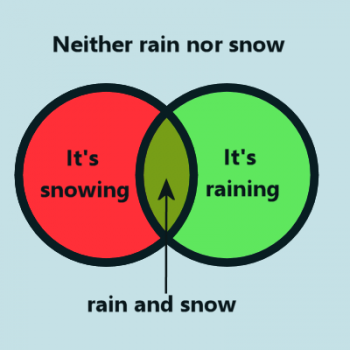
In this example, the red region represents the condition of snow, and the green region reporesents rain. Thus, the greenish-yellow region represents both rand and snow, and the blue region (outside the two circles) represents the condition that it is neither raining nor snowing. This covers all the possible conditions (that is - all the conditions we're concerned about here - there are, of course, other weather conditions like sleet, freezing drizzle, etc, but these are not our concern right now). The possible conditions are:
-
There is neither rain nor snow.
- There is snow, but not rain.
- There is rain, but not snow.
- There is both rain and snow.
Which of those four matches our initial condition? The statement "It's snowing or it's raining" is covered by the red, green, and greenish-yellow regions. That's regions 2, 3, and 4. Therefore, the the logical NOT of "It's snowing or it's raining" must contain everything except those three regions. Or, to put it more simply, it has to be only region 1 - neither rain nor snow.
So the negation of "It's snowing or it's raining" is "It's not snowing and it's not raining." Interesting, isn't it? When you negated an "or" you got an "and." Let's see what happens with our other example:
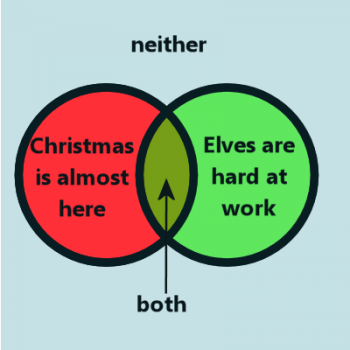
In this case, the red region represents Christmas being almost here, the green region is elves hard at work, and the greenish-yellow region is both Christmas is almost here and elves are hard at work. The light blue region represents neither of the statements being true.
So which region(s) represent our original statement? "Christmas is almost here, and the elves are hard at work." This is only covered by the overlapping greenish-yellow region.
So if we want to negate this one, we need to figure out a way of expressing everything except the greenish-yellow region. It's tempting to say that the negative of the statement is "Christmas is not almost here, and elves are not hard at work," but that is only the blue region; it doesn't include the red or the green. So instead, we need to say "Christmas is not almost here, or elves are not hard at work." Using an "or" instead of "and" allows us to include all the regions in the Venn diagram.
So our general rule of thumb is, if we're trying to negate a compound statement, we need to make sure that the original statement and it's negation cover every single region of the diagram, without any overlap.
If you've got that, you can go a little crazy with compound statements:
(It's raining and Christmas is almost here) or (it's snowing or the elves are hard at work).
Can you negate that statement?
Yesterday, I answered a question about the Monty Hall Three-Door Game, which you can read about in the previous blog post. After posting the article, I shared it on social media, and commented that talking about this problem feels like wading into a murky swamp, because everyone brings their own assumptions into the problem, and it's tough to guess what those assumptions are.
But I realized, too, that it's not just this problem; it's probability in general. I love probability, and I hate probability. Whenever a district/county/state asks me to write competition math problems for their league or math meet, I know that I need to give some probability problems - everyone expects it! But there's no kind of math problem that I'm more afraid that I'll mess up. I'm grateful for a proofreader to give my problems a second pair of eyes (although my proofreader shares my feelings about probability). More often than not, I'll figure out a way to write a program to function as an electronic simulation of my problem, to verify empirically that I have arrived at the right solution.
Anyway, one of the reasons that probability feels so murky to me is that gut reactions can lead you astray. The Three-Door game is a prime example of how those gut reactions can mess you up. Monty asks you to pick a door, knowing that one of those doors has a prize behind it, and the other two have nothing. After you pick, Monty opens one of the other doors to show you that it's empty, and asks you if you'd like to keep your original guess, or switch to the other unopened door.
Most people's gut reaction is that it doesn't matter whether you keep your original guess or switch to a different guess. This gut reaction is wrong, as you can verify by playing the simulation I built here: The Monty Hall Simulation. For those who are still struggling with this, I'd like to offer a couple different ways of looking at the problem.
The "Not" Probability
We tend to focus on the probability of guessing correctly the first time. Instead, let's focus on the probability of NOT guessing correctly. If you picked door A, then the probability that you were correct is 1/3. This means that the probability you did not guess correctly is 2/3. But really, what is that? It's the probability that either door B or door C is correct.
So if PB is the probability that door B holds the prize, and PC is the probability for door C, we can write the following equation:
PB + PC = 2/3.
Now Monty opens one of those two doors (we'll say C), that he knows is empty. This action tells you absolutely nothing about the door you opened, but it does tell you something about door C - it tells you that PC = 0.
Since PB + PC = 2/3, and PC = 0, we can conclude that PB = 2/3. This is exactly the result which the simulation linked above gives.
Two Doors vs. One Door Choice
Related to the above way of looking at it, try looking at it with a set of slightly modified rules:
- You pick a door
- Monty says to you: "I'll let you keep your guess, or I'll let you switch your guess to both of the other two doors."
Under these circumstances, of course you're going to switch. Why? Because if you keep your guess, you only have one door, but the choice Monty is offering you is to have two doors, so your probability of winning is twice as great. In a sense, that's actually what you're doing in the real game, even though it doesn't appear that way. You're choosing two doors over one, and the fact that Monty knows which one of those two doors is empty (and can even show you that one is empty) doesn't change the fact that you're better off having two doors than one.

